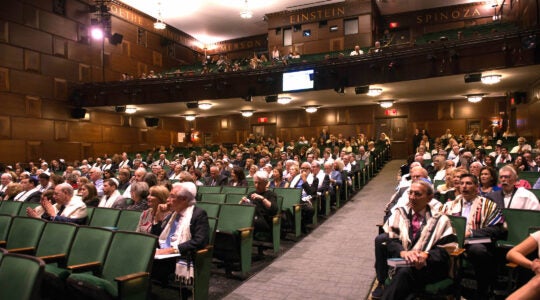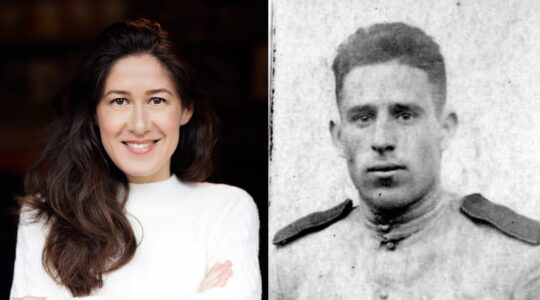Young couples and families are flooding into Washington Heights, drawn by affordable rents, convenient commutes and a vibrant Jewish community. And they are changing the look and feel of what used to be referred to as Frankfurt on the Hudson for its concentration of German Jews.
The question on people’s lips these days is, will those young families stay in the Heights, putting down roots there, or will they move on?
Take Steven Schwartzberg, for example. The former Upper West Sider is an active community builder, currently serving as secretary of Mount Sinai Jewish Center, one of the neighborhood’s Orthodox synagogues.
The Cincinnati native enjoys living in his affordable two-bedroom with his wife and 6-month-old daughter — but he doesn’t plan on staying for too long.
“In five years, chances are we would like to be in a suburb somewhere,” said Schwartzberg, 31, a marketing consultant.
Then there’s Jordan Kolar, 35. Another former Upper West Sider, Kolar is also an active member of his synagogue, the egalitarian Fort Tryon Jewish Center.
Kolar doesn’t see his Washington Heights apartment as a steppingstone to the suburbs. Instead, he plans on staying long-term with his wife and 10-month-old son — praying at FTJC, playing with his child in Fort Tryon Park and reveling in the freedom of not needing a car.
“My feeling, very much, is that we’ve found our home,” said Kolar, an attorney. “I felt that way almost immediately when we moved. Washington Heights was the neighborhood we picked because we wanted a place to settle down.”
While Kolar said most of his friends plan on staying in the neighborhood, Anat Coleman tells a very different story.
“Every summer, there’s an outflux of friends,” said Coleman, 31, the community affairs coordinator for the JCC of Washington Heights and Inwood, and a Mount Sinai Jewish Center member.
Washington Heights has an active Shabbat scene, with communal meals being the norm. At these meals, Coleman said, people often talk about where they plan on moving after their years in the neighborhood.
“That’s really hard,” she said — not only on a personal level, but also “as someone who believes in the strength of building community.”
For her part, Coleman plans on staying. Married with a 3-year-old son, the native Londoner has no immediate plans to find a home across the George Washington Bridge: “I don’t have that suburban dream; I never did.”
Many of her Orthodox neighbors on Bennett Avenue are already planning their suburban futures. As their families rapidly expand, one- or two-bedroom apartments — even affordable ones within blocks of several synagogues, and right near a supermarket with a huge selection of kosher food — just don’t provide enough space.
David Pollock, associate executive director of the Jewish Community Relations Council, called this dilemma the “second-kid barrier.”
“What happens if they have more than one child, and they want each child to have their own bedroom?” Pollock said. “To find a three-bedroom apartment is extraordinarily expensive.”
Of course, that problem extends to all Manhattan neighborhoods, and what Pollock called the “Manhattan wannabes” — Brownstone Brooklyn, for instance.
However, the Upper East and Upper West Sides tend to attract a higher-income population, while in Washington Heights, everything is about affordability.
Even members of the Heights’ longstanding German-Jewish community, which is congregated around K’hal Adath Jeshurun, known as “Breuer’s,” are leaving the old neighborhood and moving to Monsey, Pollock said: “They can get more home for less money.”
Pollock emphasized that all of this demographic information is anecdotal and not based on data from UJA-Federation’s Jewish Community Study of New York from 2002.
“The neighborhood’s too small to have a sufficient number of cases to be statistically reliable,” he said. The next geographic profile is set to come out in 2012.
In the meantime, one can just look around the neighborhood to see signs of growth and change. Fort Tryon Jewish Center is betting on its future, undergoing a multimillion-dollar renovation.
The synagogue’s membership is changing, said FTJC’s executive director, Jack Greene, over coffee at Gideon’s, an old-fashioned kosher bakery on 187th Street where one can still get a buttered bagel for a dollar.
“It’s gotten much younger,” he said. “It’s gotten more diverse.” And, at 150 members, it’s increased from previous years.
Looking dapper in a suit and tie, Greene, stands out from the elderly denizens at Gideon’s, whom he greets with familiarity. At 63, he’s lived in the Heights for almost 40 years.
“We have the people who remained, and the people who in the last decade moved into the community,” he said. “We get the young and old.”
The young often flock to Mount Sinai Jewish Center, a neighborhood heavyweight with 400 members. Friday nights on normally quiet Bennett Avenue are alive with the chatter of 20- and 30-somethings, as they spill out onto the street after services. As they catch up on a week’s worth of socializing, it’s a boisterous scene that rivals the famously lively Congregation Ohab Zedek, about 90 blocks downtown.
Unlike many synagogues, Mount Sinai’s lay leadership mostly consists of people in their 20s and 30s. Board members now serve one-year terms — a concession, perhaps, to the community’s transitional nature.
At 67, Freda Birnbaum is one of the older board members. While some longtime members have bemoaned the youth takeover, Birnbaum said there have been new efforts to reach out to the synagogue’s seniors.
“You would hear some vocal complaints for a while — older people feeling kind of left out,” she said. “[But] I think the current leadership is making a serious effort.”
Although the suburbs have eroded its population, Breuer’s remains a community stalwart, where one can still hear a choir sing on Shabbos and witness German-Jewish customs, such as a young boy bringing his “wimpel” to shul — a cloth used to swaddle him at his brit milah (circumcision), which is later used to bind a Torah scroll. K’hal Adath Jeshurun also runs several community institutions, including the mikveh and yeshiva day and high schools.
Yeshiva University, as well, is a mainstay of the community, with many people moving there because they attend (or graduated from) the school or are married to YU students, some of whom are pursuing rabbinical degrees, others studying at the various graduate schools. But the Heights proves to be a dilemma for Modern Orthodox young families once their kids reach school age since there is no Modern Orthodox school in the immediate area (Breuer’s is considered more right wing).
Hebrew Tabernacle Congregation, the Heights’ Reform synagogue, dates back to 1906 and has been located in the neighborhood since 1973. Fort Tryon Jewish Center is holding services there while its building undergoes renovation, an example of the local Jewish community’s tight-knit nature.
An unlikely social mecca is Key Food on Broadway, which features a sizable collection of kosher products under KAJ certification. On Thursday nights and Fridays, the store is crowded with people selecting their chicken from the poultry section, visiting the in-house kosher deli counter and chatting in the produce aisle.
Never a take-out bastion, save for the joints on Amsterdam Avenue catering to Yeshiva University students — Golan Heights being one popular meat option — Washington Heights now features its own kosher Chinese restaurant, three-month-old Chop Chop on West 184th Street.
Owner Shaul Rutta said he’s doing “incredible” business, averaging 175 orders daily over the summer, and he expects at least 300 a day in winter.
While some of that business comes from the local student population, Rutta said orders are coming in from families on Bennett Avenue, taking advantage of Chop Chop’s free delivery service.
It remains to be seen whether those families will stay long-term, nourishing Rutta’s business and helping its enduring survival. Anat Coleman hopes they’ll stick around, so that she can stay in the Heights, too.
“The defining factor in leaving would be if all of our friends had disappeared,” she said.
But she puts her finger squarely on the dilemma facing the Washington Heights community.
“The seniors are only going to get older, and the young people will get younger — unless we can figure out a way to make the neighborhood enticing enough that people in their 30s are going to stay,” she said.
“If over the next five years, I see that everyone has moved out, I would have to think hard about staying,” Coleman said, “which would be a real shame.”
The New York Jewish Week brings you the stories behind the headlines, keeping you connected to Jewish life in New York. Help sustain the reporting you trust by donating today.




